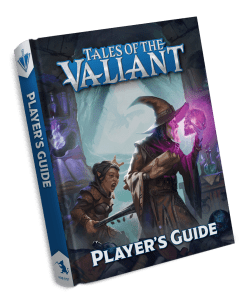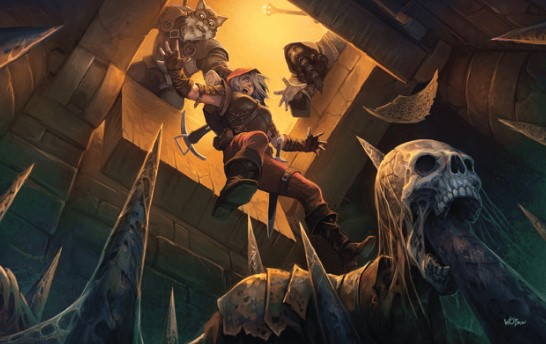
The earliest public playtests for the Tales of the Valiant RPG focused on player options, so we kept the high-level game rules in the Alpha Release pretty similar to the original SRD. This was the best strategy to get people testing player options as quickly as possible.
Some people assumed the base rules presentation in the Alpha Release was how they would look in the final book—oh man, those people will be shocked. We dug into everything, making little changes everywhere, to increase usability and address some of the more confusing pieces of the 5E rules, while keeping the base mechanics intact to ensure 5E compatibility.
What Got Better
Here are just some of the base rules elements that got major glow-ups:
- Adventuring Gear
- Tools
- Vehicles
- Light & Visibility
- Tracking & Hiding
- Downtime Rules
- Magic Item Pricing
And seriously, so much more.
Spellcasting & Spells Updates
The earliest public playtests for ToV didn’t show off all the planned changes we had for spells. Private testing, however, was a different story. Every SRD spell brought into ToV got attention, and we added a bunch of brand-new spells to round out each source list.
Speaking of which, after many votes and much discussion, we landed on the following new terms in the final versions.
- In the early playtests, “Spell levels” were renamed “spell rings,” but over the course of playtesting, the final term is now spell circles.
- In the early playtests, “class spell lists” were renamed and reflavored into four “spell circles.” While the design of the four lists hasn’t changed from playtesting, the final term for each is now spell source. Every spellcasting class chooses its spells from the Arcane, Divine, Primordial, or Wyrd source.
Refining & Rebalancing Character Options
A huge portion of ToV playtesting was dedicated to character options. Base classes, subclasses, and spells are the most complicated game elements to design, and the vast majority of audience attention is fixed on them—so we spent a huge amount of time putting them through their paces.
In most cases, each playtesting phase didn’t radically reinvent new features. We don’t think throwing new spaghetti at the wall every time makes the best product. Instead, we focused on tuning up or dialing down specific features that playtesters had issues with in playtesting. We wanted to ensure that every base class had a clear starring role in an adventuring party, so many changes were focused on enhancing those features, while ensuring no one class or player option was the obvious “best.”
Player Option Adjustments (A Quick Hit List)
The numerous rounds of playtesting we did for ToV resulted in so many changes. All of you public and private playtesters really crushed it (seriously, thank you). There are too many changes to list them all here. But here are some highlights that were a direct result of the earliest waves of public testing. (We had thousands of feedback forms submitted!)
More Choices & Power for Martials
After the first couple of playtests, y’all made it clear that empowering martial classes was a top priority. As a result, dedicated martial classes like the barbarian, fighter, rogue, and monk went through the highest number of playtest phases (a mix of public and internal).
We gave them even more strategic options (see weapon options) and ways to increase their overall damage output to compete with casters.
- The martial talent list got a complete rework from its appearance in the Alpha Release over a year ago.
- The martial talent list is now twice the size of the magic or technical talent list. And every single talent option is great. We wanted them all to feel as juicy as 5E’s Sentinel or Polearm Master feats.
Bard
Here are some changes that addressed feedback from the bard class public playtest:
- You start with two Bardic Performance options instead of one (this was a popular playtester ask). Spoiler alert: one is Cutting Words! We thought it felt too ultra-bard to keep hidden behind one subclass.
- While bards are still tied to the Arcane spell lists, they now get to pick a percentage of their spells from any spell source! This means bards can still grab tried-and-true support spells like cure wounds.
- Also, there is no need to panic—the vicious mockery spell is on both the Arcane and Wyrd source lists, so it’s back in the bard realm.
Druid
Here are some changes that addressed feedback from the druid class public playtest:
- Druids start with a second Wild Shape option—for those less interested in Wild Shape: Beast Form and prefer to be spell-slinging powerhouses.
- After lots of divisive feedback on how Wild Shape: Beast Form should work, we kept the creative spirit of the feature the same but imposed restrictions on form hit points by size & druid level. We also set a specific number of known forms. The playtesters spoke—and y’all weren’t interested in a total rework–so we focused on quality of life and clarity improvements instead.
Mechanist
We already showed off some of the changes from playtesting in the article, previewing the first couple of pages of the brand-new mechanist class. But in case you missed it, we made the mechanist stronger in combat:
- Mechanists have the same weapon option benefits as the other martial classes.
- Mechanists have Multiattack.
- We boosted features that made them tougher, providing more options to boost hit points and increase AC.
Warlock
From the earliest days, we were determined to make changes to make the warlock casting system less of a headache. The first time we released the warlock class into public playtesting, we introduced it as a half-caster in the same style as the paladin and ranger.
We got a lot of feedback, and it was a nearly 50/50 split between playtesters who LOVED the change and those who mourned the loss, specifically of the old way of Pact Casting.
After much consideration, we created a hybrid option—warlocks are half-casters like the new design (which means they have more spell slots). But! We gave them access to cantrips and brought back Pact Casting in a fun new form that allows warlocks to cast a small number of pact spells without expending spell slots.
We think you’ll dig it, no matter which camp you fell into during those public playtests.
And, of course, there was much more! check back next ToV Tuesday for more!
Campaign Builder: Dungeons & Ruins is live on Kickstarter!
For our 30th Kickstarter project, Kobold Press delves deep into the tabletop tradition of exploring dusty crypts and lost caverns—and plundering the heck out of them.
On day 1, the campaign is 200% funded and stretch goals yawn wide below!
Go see!


I’m starting to take this Monk Silence policy very personal!
Do we have an ETA on PDF’s for the core book?
Oh Great and beautiful Post for us and your post is remarkable for us people should learn from your article Keyboard Puffer Jacket is for Men’s and Women’s and in very reasonable prices
You have a real gift for storytelling. I felt like I was right there with you as you were exploring this topic
Good to hear that! improving while maintain 5E compatibility and can’t wait to see the final version of it. Beside that if you’re looking for some game character outfits check out this Saga Anderson Alan Wake 2 FBI Jacket.
I was extremely impressed with the variety of Incredibox versions. Each version offers a different musical style and atmosphere, from the fun tunes of V9 Wekiddy to the deep sounds of V4 The Love. This not only keeps the game fresh but also gives players a lot of options to express their creativity.
Love the game. Why no Dex fighter specific Talents? Also, some of the Technical talents should be available to everyone (e.g. Bottomless luck, Hard Target, etc). No reason I can think of to restrict these to restrict them to specific subclasses. My 2 cents. Thanks for producing a better game than D&D.
Try playing Press ctrl, a puzzle game. This game has 4 stages, but it is very difficult. Do you dare to take on the challenge?
It’s been such a rewarding ride to see how community input actually shaped the final version of the book. As someone who was deep into the playtest, it’s wild to flip through the pages and spot mechanics, lore tweaks, and even dialogue that echo our feedback. This feels less like just a rulebook and more like a collaborative legacy built by the devs with the players. Major props for listening, refining, and making this world richer than ever!